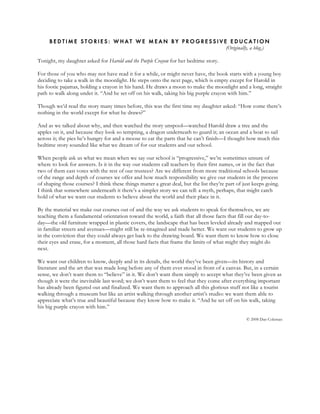More Related Content
Similar to bedtime stories
Similar to bedtime stories (16)
bedtime stories
- 1. B E D T I M E S T O R I E S : W H A T W E M E A N B Y P R O G R E S S I V E E D U C A T I O N
(Originally, a blog.)
Tonight, my daughter asked for Harold and the Purple Crayon for her bedtime story.
For those of you who may not have read it for a while, or might never have, the book starts with a young boy
deciding to take a walk in the moonlight. He steps onto the next page, which is empty except for Harold in
his footie pajamas, holding a crayon in his hand. He draws a moon to make the moonlight and a long, straight
path to walk along under it. “And he set off on his walk, taking his big purple crayon with him.”
Though we’d read the story many times before, this was the first time my daughter asked: “How come there’s
nothing in the world except for what he draws?”
And as we talked about why, and then watched the story unspool—watched Harold draw a tree and the
apples on it, and because they look so tempting, a dragon underneath to guard it; an ocean and a boat to sail
across it; the pies he’s hungry for and a moose to eat the parts that he can’t finish—I thought how much this
bedtime story sounded like what we dream of for our students and our school.
When people ask us what we mean when we say our school is “progressive,” we’re sometimes unsure of
where to look for answers. Is it in the way our students call teachers by their first names, or in the fact that
two of them cast votes with the rest of our trustees? Are we different from more traditional schools because
of the range and depth of courses we offer and how much responsibility we give our students in the process
of shaping those courses? I think these things matter a great deal, but the list they’re part of just keeps going.
I think that somewhere underneath it there’s a simpler story we can tell: a myth, perhaps, that might catch
hold of what we want our students to believe about the world and their place in it.
By the material we make our courses out of and the way we ask students to speak for themselves, we are
teaching them a fundamental orientation toward the world, a faith that all those facts that fill our day-to-
day—the old furniture wrapped in plastic covers, the landscape that has been leveled already and mapped out
in familiar streets and avenues—might still be re-imagined and made better. We want our students to grow up
in the conviction that they could always get back to the drawing board. We want them to know how to close
their eyes and erase, for a moment, all those hard facts that frame the limits of what might they might do
next.
We want our children to know, deeply and in its details, the world they’ve been given—its history and
literature and the art that was made long before any of them ever stood in front of a canvas. But, in a certain
sense, we don’t want them to “believe” in it. We don’t want them simply to accept what they’ve been given as
though it were the inevitable last word; we don’t want them to feel that they come after everything important
has already been figured out and finalized. We want them to approach all this glorious stuff not like a tourist
walking through a museum but like an artist walking through another artist’s studio: we want them able to
appreciate what’s true and beautiful because they know how to make it. “And he set off on his walk, taking
his big purple crayon with him.”
© 2008 Dan Coleman
